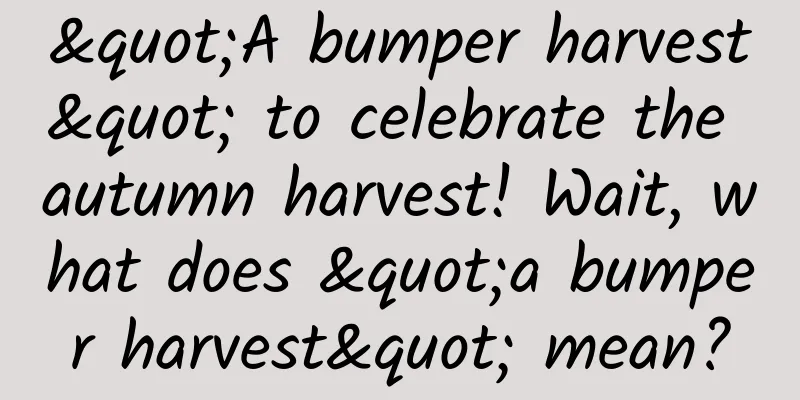"A bumper harvest" to celebrate the autumn harvest! Wait, what does "a bumper harvest" mean?

|
In the golden autumn of October, fruits and vegetables are fragrant, crabs are plump, and chrysanthemums are yellow, which is a scene of good harvest. my country has a tradition of celebrating the harvest since ancient times. The ancient "Autumn Festival" was an activity to worship the God of Land after the harvest. People thanked the God of Land for his generosity and prayed for a good harvest in the new year. There are different opinions about the "five grains" in "a bumper harvest of five grains". The mainstream view is that they are rice, millet, sorghum, wheat, and beans, which played an important role in the daily diet of the ancients. We have talked about the word "gu" in the previous article. It has two sources: one is the "gu" in "valley", and the other is the "gu" in "five grains". The "gu" in "valley" is a pictograph, so we will not go into details here. The "gu" in "five grains" is written as "gu" in traditional Chinese, which is a phono-semantic character. Its radical is "禾", indicating that it is related to crops; the rest are the phonetic radicals. Later, because there were too many strokes, it was simplified to "gu". "Five grains" can be understood as five major grain crops, or as a general term for crops and grain crops. What does "丰登" mean? Let's talk about "丰" first. This word also has two origins, one is "丰" and the other is "豐". The oracle bone script of "丰" looks like a lush tree on a mound of earth. What does it mean? We can understand this character from two perspectives. From the perspective of the tree, the trees are lush, so the original meaning of "丰" is lush vegetation. The reason why this tree grows on the mound of earth is that someone planted it. What is the purpose of planting trees? It turns out that the ancients planted trees around the land they divided to mark the boundaries of the land. This meaning was later written as "封" in "分封", so "封" actually developed from "丰". Back to the character "丰", since its original meaning is lush vegetation, it is easy for us to understand what "百草丰茂" means. Lush vegetation means a good harvest, so "丰" can also be extended to mean a good harvest, such as "丰收" (a bumper harvest) and "稻花香里说丰年 (a good harvest)". Lush vegetation can also be extended to mean full or sufficient, such as "丰满" (full) and "丰盈" (abundant). When Chinese characters were simplified, "豐" was also simplified to "丰". The early form of "豐" had "豆" under it, which was a container for things, and two strings of jade were placed inside as sacrifices. Therefore, the original meaning was that the sacrifices in "豆" were sufficient. From this, the meanings of "many" and "abundant" were derived, such as "rich", "abundant", and "well-fed". It was further extended to mean big and high, such as "monument" and "great achievements". So, what is the meaning of "丰" in "五谷丰登"? Obviously, it means a good harvest, not the simplified Chinese character for "豐". Let's look at the character "登". We have mentioned it before: its oracle bone script has two feet on the top; the "豆" in the middle is a container for holding things; and two hands on the bottom. Later, some characters omitted the two hands and gradually evolved into the current "登". From the picture, this character is a container full of grains held high with both hands, and step by step, walking up the steps to offer it to the gods. The grains here are not ordinary grains, but newly harvested grains, which are to be tasted by the gods. The ancients attached great importance to sacrifices, and always chose the best things to offer to the gods or ancestors. For example, "祭" is a cow with no variegated fur, "牲" is a cow with no defects on the body, "祭" is to put the meat on the altar, and "福" is to offer wine to the gods for blessings, etc. The grain that has just been harvested is the most precious in the hearts of farmers, so it is used for sacrifice. If we see "农乃登黍" and "农乃登麦" in classical Chinese, we can guess that they are offering new grains. Only when the crops are ripe can people offer them as sacrifices, so "deng" is extended from offering new grains to the ripening of crops. In ancient my country, the solar term "Chushu" was divided into three phases: "The first phase is when eagles offer sacrifices to birds; the second phase is when heaven and earth begin to be solemn; the third phase is when the crops are ready." Here, "the crops are ready" means that the crops are ripe. Similarly, "a bumper harvest of grains" means a good harvest of grain. "A good harvest" is the simplest and best wish of farmers. In this golden autumn season, people enjoy the fruits of the harvest and express their joy of the harvest. (The author Li Ying is a member of the Science and Literature Committee of the China Science Writers Association and a doctor of literature) |
>>: This kind of fossil is called the "time pointer" of the rock layer
Recommend
The official TV version of "Three Kingdoms Heroes" is launched
Speaking of Three Kingdoms games, KT Pants-Taking...
Cold Dew: Do you listen to the "Autumn Johns Song" or follow the "Autumn Freeze" principle?
There is a proverb that goes, "After eating ...
What the heck is 10-bit? Does it really make images look amazing?
There are always countless mysteries and gimmicks...
Although it is a fight between the same school, it is also a bloody battle. Galaxy E8 and Zeekr 007, which one do you choose?
As we all know, the development speed of the dome...
How to quickly find mini programs in WeChat?
On January 9, 2017, WeChat Mini Programs were off...
A comprehensive summary of design anomalies and how to handle them
In design, some abnormal situations are often eas...
Traffic, winners, paid future... this year of content entrepreneurship!
The top picture of this article is Luo Zhenyu, th...
How are diamonds cut? Do they cut themselves?
Diamonds are considered money-eating beasts by so...
Tencent Weibo is officially closed: Currently unable to log in, users can apply for personal content backup
On September 29, at 23:59 last night, Tencent Wei...
User growth activity matrix for online education
Online education has developed rapidly in 2020 an...
Calendar: Holidays over Body: No, not yet
The Spring Festival holiday was like a tornado Th...
Labor Day Marketing Case Study
In the past, I thought that the inevitable "...
Tiktok account system creation, in-depth analysis of Tiktok novice account creation skills and cooperation with cross-border e-commerce development final value 1980 yuan
Tiktok account system creation, in-depth analysis...
Feelings can’t fill your stomach. How difficult is it to make a good independent game in China?
In recent years, more and more independent games ...
The clearest and most comprehensive method for writing operation and promotion plans!
Operations are basically a process of constantly ...






![Zero-based video account to make money, 0 cost, 0 threshold, easy daily income of 300+ [Video Tutorial]](/upload/images/67cc0fab497de.webp)


